Ochirova Tatyana Nikolaevna, school number 49 G. Ulan-Ude
HOW TO START A COMPOSITION
The construction of the introductory part of the composition usually causes the greatest difficulty. Entry options.
1. Definition in the introduction of the topic and the mainthoughts of the text with concretization and comments in the afterblowing parts.
Morning is the time when all living things awaken from sleep.Freshness and brightness of morning colors, morning coolness,sparkling dew create a special mood in nature, whichis transmitted to people rising with the first rays - "mi of the sun, as a priceless gift, as the highest reward for opento this world. About this text wonderful Russian pithe clerk of Vladimir Soloukhin.
Using this option of constructing the introductory part, you need to strive for a capacious and, as far as possible, exhaustive definition of the main thoughts of the text, and also remember the need for their further commentary, which can be expanded as a concretization of the author’s thoughts, or as an analysis of the language and composition used by the author to express these thoughts funds, or as an expression of one’s position in relation to the topic disclosed by the author.
2. The definition in the introductory part of the problems thatthe author picks up or touchestext analysis.
What is true friendship? What value does it havefriendship compared to the most important, urgent work,person's professional responsibilities? How to savethose cordial, good relations that connect a person with friends? What does friendship mean for a person?holding in difficult times of his life? The text of V. Astafiev makes us think about this.
This entry option is suitable for constructing reasoning on a problematic text, the analysis of the content side of which requires identifying those issues (problems) that worried the author. In the following parts, the following should be revealed: a) the position of the author in relation to the problems raised by him; b) the position of the graduate; c) analysis of the language tools used by the author. The author’s position and the position of the graduate can be presented in any sequence that does not violate the logic of the deployment of the statement, or in correlation.
3. Expression in the introductory part of your position.
Intelligent people are now usually called those who, by occupation, have to engage in mentallabor: teachers, doctors, engineers. But in my opinionnot everyone involved in intellectual activity,worthy of being called an intellectual. In my understandinga tellent person is a person who is deeply decent, withhonest, honest with othersand to yourself. Reading the text From Zalygin, I once again assertedhe was in his opinion on this issue.
When setting out our position in the introduction, we must not forget about the requirement to express our attitude only to those thoughts that are reflected in the author’s text. Do not go away from the text!Remember that essays written without reliance on the proposed text are not checked or evaluated.
4. A brief message about the writer - author of the text: about the main problems that he touched on in his works, and about the connection of the problem raised in the text with the general focus of his work. Information about the writer must be given in an extremely compressed volume (no more than 3 prepositions). This introduction is appropriate if you know the other works of the writer well.
V. Soloukhin is one of those writers about whom you can say: "This is the artist of the word." The descriptions of nature created by him are fascinating, surprisingly accurate, emotional, his statements about man. In his work, Soloukhin repeatedly raised the topic of the relationship between man and nature. He turns to this topic in a test about a beautiful dewy morning.
5. Lyrical thinking.It presupposes the utmost sincerity, revelation, and at the same time requires the ability to subordinate the flow of feelings to strict logic, dictated by the requirement of content and proportionality of the composition of the composition.
Probably every person at least once met the dawn! How amazing is the grass sparkling with dew in the rays of the rising sun! What about flowers? What about birds? How to express the general mood of the awakening nature, which is transmitted to us. This is what the text of Vladimir Soloukhin says.
6. One of the elements of the introduction may be a quote taken from a text or other sources.You need to be very careful when choosing a quote.
Two feelings are marvelously close to us
They find food in the heart:
Love for the native ashes
Love for fatherly coffins -
these immortal lines of A. S. Pushkin were recalled to me when I read the text of F. Iskander "Grandfather's House".
Follow the plan when writing an essay !!!
Preparation for the exam
how
learn to write an essay
(Part C. Work on the introduction to the essay)
Teacher: Ochirova T.N.
Choreographic terminology is a system of special names designed to indicate exercises or concepts that are difficult to explain or describe briefly.
In the XVII century (1701), the Frenchman Raoul Feye created a system for recording elements classical dance. These terms are recognized by experts in the field of world choreography at the present time.
Turning to the specialized literature, students experienced difficulties, encountering unfamiliar terms, such as: “Eversion of the legs”, and this is a necessary and necessary condition for the technique of performing elements of classical dance, “Body” in gymnastics is an unacceptable term, it is replaced by “Posture” , “Ballon” - the ability to fix a pose in a jump, “Force” - the necessary preparatory hand movement to perform pirouettes, “Aplomb” - a stable position of the student, “Elevation” - the athlete’s ability to show maxi the small phase of the flight in a jump, "Prior" - preparatory exercises hand or foot before the start of the element, “Cross” - the execution of elements in the following directions: forward, side, back, side, or in the opposite direction.
Knowledge of special terms speeds up the learning process. Choreographic terminology characterizes the movement in more detail than the gymnastic. This is the international language of dance, the ability to communicate with choreographers, understanding of special literature, the ability to briefly record training combinations, lessons, studies, floor exercises, and compositions.
The terminology is always built in accordance with the rules of word formation. The main advantage of the term is in brevity. This makes it possible to reduce the time for explanation of tasks, to maintain the density of the lesson.
But students are not always able to remember choreographic terminology, so the idea arose of writing elements of choreography using gymnastic terminology, for more accessible perception by students of the material studied.
Experience shows that it is students who do not have choreographic training who have difficulty remembering the names of movements. As a rule, these are trampolines and jumpers on an acrobatic track. But athletes who have completed the CCM and MS standards do not always have knowledge of the terms and the correct technique for performing even the simplest elements. The creation of this kind of table, a large number of illustrations for the elements make it possible to streamline students' knowledge in the field of choreographic training, fluency in the terms of choreography and, if necessary, use special literature on choreography.
HAND AND FOOT POSITIONS IN CLASSICAL DANCE HAND POSITIONS
preparatory
Hands down, rounded at the elbow and wrist joints, palm up. Thumb inside palm
I - first
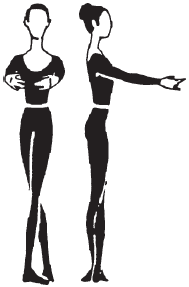
Arms forward, rounded at the elbow and wrist joints
II - second
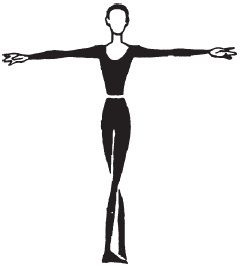
Hands forward to sides, rounded at the elbow and wrist joints, palms inward
III - third
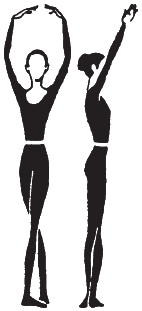
Hands forward upward, rounded at the elbow and wrist joints, palms inward
HAND POSITIONS
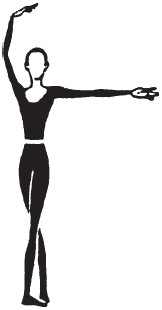
Right hand in third position, left hand in second position
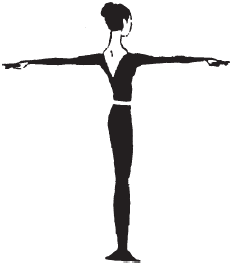
Right hand forward, palm down, left hand back, palm down

Right hand in second position, left hand in preparatory position
The right hand in the first position, the left hand in the preparatory position
Right hand in third, left hand in preparatory position
LEG POSITIONS
I - first
Closed Sock Stand Out. Heels are closed, socks are out. The legs are in line with the uniform distribution of the center of gravity throughout the foot
II - second
Wide leg stand apart socks outward. The legs are spaced from each other on the same line at the distance of one foot with a uniform distribution of the center of gravity between the feet
III - third

The right one is placed in the middle of the left foot (toes out)
IV - fourth
Leg stand apart, right in front of the left (at the distance of one foot) socks outward (performed from both legs)
V is the fifth

The closed stand is right in front of the left, the socks are out (the right heel is closed with the toe of the left, performed from both legs)
VI - sixth
Closed stance (heels and socks closed)
LIST OF EXERCISE ELEMENTS
Exercise - choreographic exercises in the prescribed sequence at the support or in the middle.

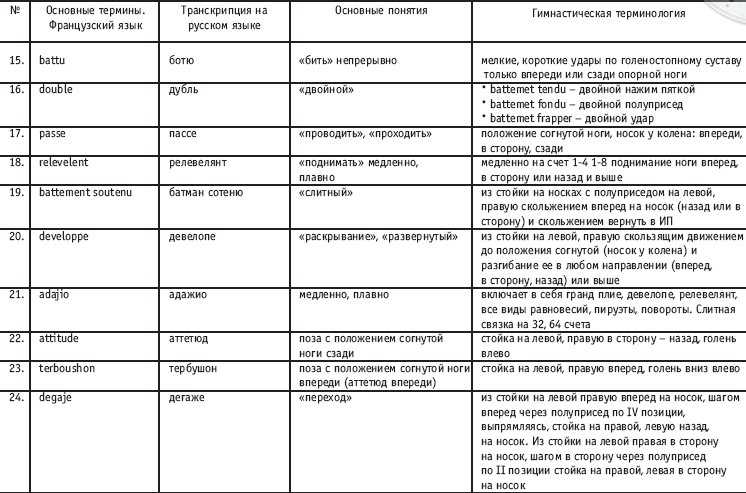
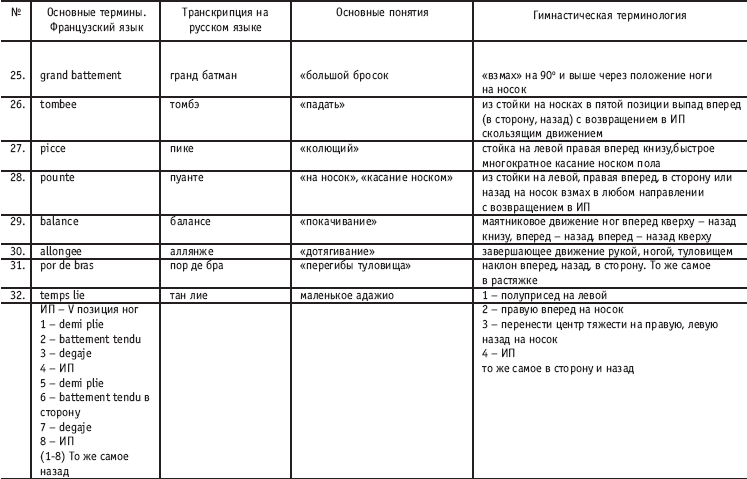

TURNS 90 °, 180 °, 360 °, 540 °, 720 °, 1080 °.
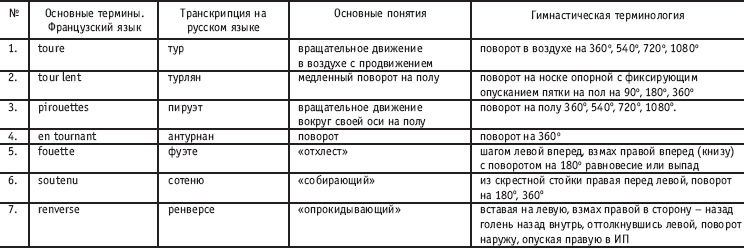

METHOD OF TEACHING THE BASIC ELEMENTS OF EXERCIS
DEMI PLIE, GRANA PLIE (SEMI-PRESIDENT, PRISCESS)
The purpose of the exercise is to develop the elasticity of the joint-ligamentous apparatus and “eversion” in the hip, knee and ankle joints. Exercise contributes to the development of jumping by stretching the Achilles tendon.
Half squat(demi plie)
The semi-squat is performed on all positions. In this exercise, the heels do not come off the floor, the weight of the body is distributed evenly on both legs. The bending and extension of the legs is performed smoothly, without stopping, “eversion”, the knees are directed to the sides, along the shoulder line. Posture is straight.

Squat(grand plie)
Squat is performed on all positions. First, the semi-squat is smoothly performed, then the heels gradually rise, and the knees bend as much as possible. During extension, the heels first lower to the floor, then the knees straighten. When lifting the heels do not rise high on the toes. An exception is the grand plie in the second position, where the heels do not come off the floor due to the wide position of the legs.
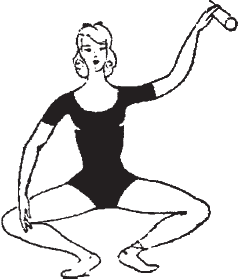
Flexion and extension should be performed smoothly, at the same pace. The pace is average. Before the start of the exercise, the hand (if the movement is performed at the machine) or both hands (if the movement is performed in the middle) are transferred from the preparatory position from the preparatory position through the first position to the second. Then, with the beginning of the bending of the legs, the hand (or both hands) falls from the second position to the preparatory one, and with the beginning of the unbending of the legs, the hand is again transferred through the first position to the second.
BANTMAN TANDIU (EXTENDED)
(position of the foot on the toe forward, sideways, backwards)
Flexion and extension of the foot by sliding on the floor to the position of the foot on the toe. It is carried out from the first or fifth position in three directions: forward, sideways, backwards.
The purpose of the exercise is to teach you how to properly extend your leg in the right direction, to develop strength and elasticity of lifting (ankle joint) and a beautiful line of legs.
Batman tandyu(right side to toe)
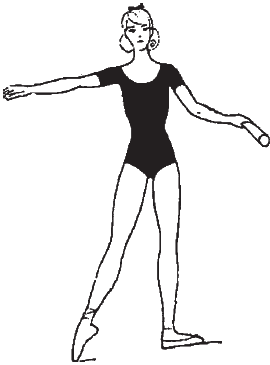
Batman tandyu forward(right forward on toe)

Banman Tandyu back(right back to toe)
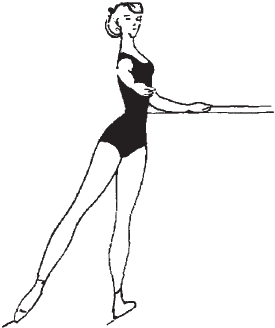
Batman tandyu back and forth runs along a line strictly perpendicular to the body, and to the side - exactly along the shoulder line. When performing a batman tandyu, the entire foot slides on the floor first, then fingers and lifting gradually extend. The center of gravity of the body on the supporting leg, the sock does not come off the floor.
Make sure that the knees remain extremely elongated and both legs maintain an “eversion”. At the time of reaching the legs should not be emphasized on the toe. When the foot returns to its original position, the foot gradually drops to the floor. The heel drops to the floor only in the starting position.
When performing forward, the glide begins with the heel, and back the foot returns with the toe to the SP. When performing backward, the slip begins toe, and back foot returns heel in PI.
4/4 , the pace is slow. Later, the move is made out of downtime. Music size -2/4, the pace is average.
BATMAN TANDIU JETE (WAVE)
It develops muscle strength, the beauty of the line of the legs and clarity of execution.
Small, clear leg swings to the bottom and return to the starting position through the batman tandyu.
It is performed in the first or fifth position in three directions: forward - downward, sideways - downward, backward - downward.
Batman tandyu are sideways
(swing right to side - down)

Batman tandyu get ahead
(swing right forward down)

Batman tandyu are getting back
(swing right back down)

Batman tandyu zheta is performed in the same way as batman tandyu, but when reaching the position on the toe, the leg does not stop, and with a wave continues to move, where it is fixed at the height of the middle of the tibia of the supporting leg (45 °). Both legs should be “eversion”, the muscles of the legs are tightened, and during the swing, the lift and toes of the working leg should be extremely tight.
The PI returns with a sliding movement through the position on the toe.
Musical size at the beginning of learning - 4/4 or 2/4, the pace is slow. As you master the exercise, a swing of the leg is performed from the start, the pace is average.
GRAND BATMAN (WAVE RIGHT FORWARD, INTO THE SIDE, BACK)
In this position, the leg is located both when performing large Jettons (sweeps), fixed at 90 °, and when slowly raising the leg - it is relevant.
Forward leg position
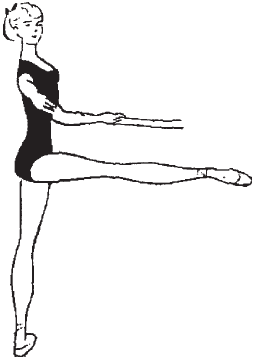
Side to side
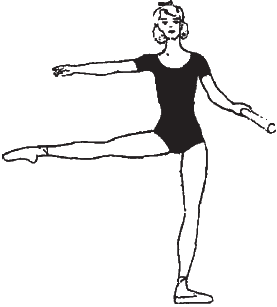
Leg position back
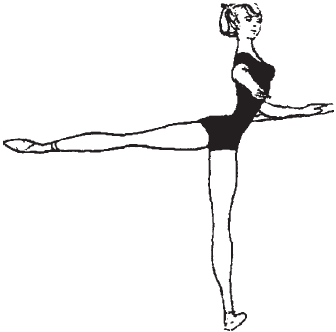
Large swings into the air and return to the starting position are performed in the first or fifth positions in three directions: forward, side, back. From the starting position, the leg swings up into the air with a sweeping motion along the floor, like in the tandyu batman, with the legs locked at 90 ° (hereinafter), and returns by sliding through the tandyu batman to the SP. Keep track of the “eversion” and tension of the knees, lifting and toes of the working leg. Move the center of gravity of the body to the supporting leg. When performing a large swing forward and to the side, the body should remain strictly vertical. When swinging backward, a slight torso forward is permitted.
Musical size - 4/4. At the beginning of learning, the pace is slow. As you master the swing of the foot is performed due to the beat, the pace is average, and the height of the swing increases in three directions: up and then up.
When relevane is performed, the foot slowly rises forward, sideways or backward and also slowly lowers to its original position (through the tandem batman). As you master, the height also increases, as in the Grand Batman up and up.
ROND DE JAMBES PARTER (CIRCULAR SOCKET FLOOR)
The main objective of the exercise is the development and strengthening of the hip joint and the necessary “eversion” of the legs.
The movement is forward - en deor and back - en de dan.
En deor(out)
From the first position, the sliding movement forward to the toe (batman tandyu), while maintaining the maximum “eversion” and stretching of the legs, is translated by sliding into the second position to the position right to the side on the toe, then, while maintaining the “eversion” and tension, it is carried back to the toe (batman) tandyu) and returns by sliding to the starting position
An Dedan(inside)
When performing the exercise back (en-sedan), the leg from the first position is slid back to the toe, then moved to the side by the slip on the toe (to the second position), from the second position by the slip to the right position forward to the toe (Batman tandyu) and returns to the original position by sliding position
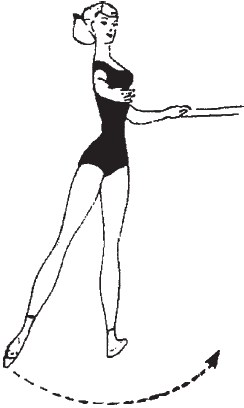
The center of gravity of the body remains on the supporting leg. The working leg should pass “inverted” all the basic positions of the legs on the toe at the same pace. Through the first position, the leg is held in a sliding motion with the mandatory lowering to the floor of the entire foot.
The musical size is 3/4, 4/4, the tempo is average.
POR DE BRA (EXERCISES FOR THE BODY AND HANDS)
A group of exercises that develops flexibility of the body, smoothness and softness of the hands, and coordination of movements.
Here one of the forms of pore de bra is given, which consists in bending the body forward and unbending it, tilting the body back and returning to its original position.
The exercise is performed at the support and in the middle of the hall from the fifth position in the face position (full face) or in half a turn (cruise, efas). Before starting the exercise, the hands are transferred from the preparatory position through the first to the second.
Fifth foot position, second hand position
The closed stand is right in front of the left, the socks are out, the right heel is closed with the toe of the left. Hands to the sides, rounded at the elbow and wrist joints, palm forward, thumb inward.
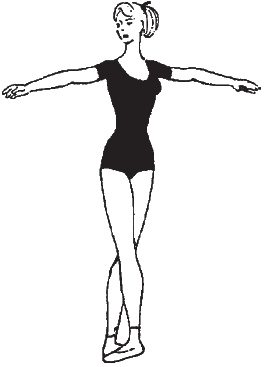
Fifth foot position, third hand position
Por de bra forward, arms in third position (torso forward, arms up, rounded at the elbow and wrist joints).
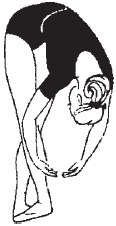
Fifth foot position, first hand position
The closed stand is right in front of the left, the socks are out, the right heel is closed with the toe of the left. Arms forward, rounded at the elbow and radial-metacarpal joints, palms inward.
Por de bra back, third hand position
Torso tilt back, arms up, rounded in the elbow and wrist joints, turn the head to the right (tilt the body back only with your shoulders back, without relaxing the muscles of the lumbar).
Perform the exercise smoothly, observing the exact position of the hands, accompanying their movement with a look and a turn of the head. The musical size is 3/4, 4/4, the pace is slow.
SUR LEU KU AE PIE (FIXED PROVISIONS OF THE BENT FOOT ON THE ANKEY)
The position of the foot on the ankle (sur le ku de pied) to perform batman frappe, batman fondue, bird batman, botu. The right one, bent with a slightly unbent foot, is located above the ankle of the other leg, touching the outer part of the foot. Fingers laid back.
The position of sur le cu de pied is performed front and rear. In both cases, the knee of the bent leg should be “eversion” and directed exactly to the side along the shoulder line.
Sur le ques de pied
(main ankle position in front)
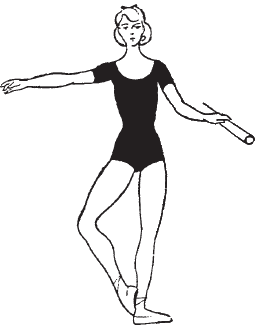
Sur le ques de pied
(main ankle position at the back)

Batman frappe consists of bending the working leg to the position of sur le qué de pied and extending it to the toe at the initial stage of training, and as they are assimilated in the downward position in the groups UTG-2,3, and in the groups UTG-4, SS, HSR - on half-fingers with lowering in various poses in a position on the toe or down.
First, the exercise is learned with the legs extended to the side, then forward and later back to the support at a slow pace. It is necessary to monitor the maximum “eversion” of the leg in the hip, knee and ankle joints.
When the bending and extension of the leg in all three directions has been mastered, the bending of the leg will be performed from the dact, with an emphasis on the extension of the leg.
Musical size - 2/4, the pace is average.
At first, only the position of sur le cu de pied front and back is unlearned. The leg from the fifth position is fixed above the ankle of the other leg and again lowers to the fifth position. This exercise is recommended to be learned to face the support. It is necessary to monitor the maximum “eversion” of the leg in the hip, knee and ankle joints, while maintaining proper posture and the center of gravity of the body on the supporting leg.
As you master the position of the legs on the ankle in front and behind, you learn how to change the position of the front and back at a slow pace, and as you master it, at a fast pace. For learning the double frappe in the groups UTG-3, UTG-4 at half-fingers and in combination with demi-plie in poses.
The position of the feet on the ankle (sur le quou de pied) to perform batman fondue. This exercise consists in bending the leg to the position of sur le coupe pied with an extended “lift”, simultaneous half squat on the supporting leg and extension of the working leg to the toe or down in one of three directions.
Sur le ques de pied
in front (conditional position of the foot on the ankle in front)
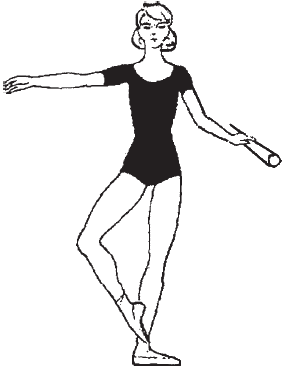
Sur le ques de pied
back (conditional position of the foot on the ankle in the back)
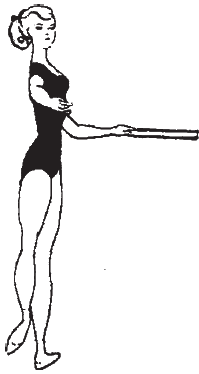
At first, only the position of sur le cu de pied is learned in front, then behind. After this, the semi-squat on the supporting leg is learned and the extension of the working leg is first to the side, then forward and backward facing the support
Musical size - 2/4, the pace is slow. The movement is very smooth.
It is necessary to monitor the “eversion” of the legs and the distribution of the center of gravity of the trunk on the supporting leg. When the movement is well understood, various hand positions can be introduced, especially when performing exercises in the middle of the room. In the UTG-3 group, the double batman fondue is unlearned, and in the UTG-4, SS, HSR groups the exercise is performed at half-fingers.
PASSION (TRANSFERS - “REVERSE” POSITION OF THE BENT FOOT FORWARD, INTO THE SIDE AND BACK, SOCKS AT THE KNEE).
DEVELOPMENT (BENDING AND EXTENSION OF FEET 90 ° AND ABOVE)
Exercise develops “eversion” in the hip, knee and ankle joints and is a leading exercise for development.
Pass for development ahead
Stand on the left, right bent at the knee toe in front.

Pass for development back
Stand on the left, right bent to the side, toe at the knee at the back.

Pass to carry out development aside
Stand on the left, right bent to the side, toe at the knee to the side.
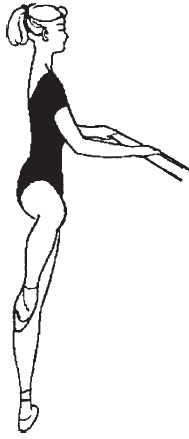
If the leg will be bent forward, then from the starting position it is transferred from the position of sur le qué de pied in front. If the leg is bent backward, from the position of sur le qué de piet from behind.
Then the working leg slides up along the supporting leg (but not touching it) and opens in the desired direction. If the leg extends to the side, then, without bringing the sock to the knee of the supporting leg, it needs to be transferred to the inside of the supporting leg and then unbent.
When performing, it is necessary to monitor the “eversion” of the thigh, the tension of the lift and fingers.
When the pass is well mastered, the second part of the movement is introduced - leg extension in one of three directions forward, sideways, backwards. First, development is unlearned to the side, then forward and later backward. To the side and back, leg extension is learned to face the machine. The movement is smooth. It is necessary to monitor the "eversion" of the leg during its extension and return to its original position. The musical size is -3/4, 4/4, the pace is slow. When performed in the middle, various turns of the torso and position of the arms can be given. The position of the pass can be applied when moving the legs from one pose to another.
Development is carried out from the fifth position in the groups UTG-3, UTG-4, SS, HSR in the upward position, and as they are assimilated upward in three directions and at half-fingers, in poses, in combination with elements of the chosen sport.
“External storage medium” - Optical drives. Floppy disks. Optical discs. Rewriting technology. HDD. Flash memory cards. The use of flash memory. External memory Information. Flash memory The main carriers of external memory.
“CD DVD” - Want to talk more about the company more convincingly? The DVD consists of a 0.6 mm film coated with aluminum and glued onto a clean substrate. For zone 5 discs, translation of films into Russian is required. You can get intentionally non-deactivable subtitles on the English track. Cost: CGMS information is embedded in the outgoing video signal.
“External memory devices” - The use of flash memory cards. Recording layer. Laser drives and disks. Long-term storage. Information. Hard magnetic drives. Floppy disks. Flash memory cards. Manufacturers The core of the magnetic head. Disk drives. The speed of reading information. External memory Optical principle.
"Computer memory" - Nmzhd. Controllers MEMORY Internal and external. Information highway (bus). Computer (calculator). Conclusion. Memory. Information exchange in komputer. The main devices of a personal computer. CPU. 0 or 1. Enter. Output devices. Addressability. Memory cards. System unit.
"Types of computer memory" - Internal memory. A kind of ROM. BIOS A memory module with two rows of contacts. RAM. Video memory The memory is implemented on statistical memory chips. Types of computer memory. ROM. Special memory. Capacity. Installed on the system board. High speed electronic memory.
“Computer memory” - Data from the mouse - 1 time per year. Moving the mouse pointer from one corner of the screen to another is a millennium. Examples of repositories: document archives, libraries, directories, file cabinets. Data from the railway or laser disc - 1 byte per hour. Comparative characteristics of memory devices. Output devices. The speed of modern computers has crossed the line of hundreds of millions of bits per second.
Brief description of Australiahelp to build a common opinion and determine whether it is worth it.
Geography and nature of Australia
Australia is the sixth largest country in the world in terms of territory, and it is the only state to occupy a whole continent. Few people know that the full name of Australia is Union of australia. The structure of this state, except the mainland itself, includes about. Tasmania and other islands. The mainland is washed by the Pacific Ocean in the east, the Indian Ocean - in the west and south. Mainland Australia is separated by the Bass Strait 240 km wide from about. Tasmania in the southeast and the Torres Strait 145 km wide from about. New Guinea in the northeast. The shortest distance from Australia to Indonesia through the Timor Sea is 480 km, and to New Zealand through the Tasman Sea 1930 km. Australia stretches for 3,180 km from north to south and 4,000 km from east to west. This is the smallest mainland: its total area, including the island of Tasmania, is 7682.3 thousand square meters. km The coastline is 36,700 km. In the north, Carpentaria Bay extends deep into the land, and in the south - the Great Australian Gulf.
On the territory of the mainland, diverse nature is adjacent to modern densely populated megacities. Although most of the continent is occupied by semi-deserts and deserts, Australia has a variety of landscapes: - from alpine meadows to the tropical jungle. Australia has become home to unique species of flora and fauna, some of which are not found in other parts of the world. Many plants and animals, including giant marsupials, became extinct with the advent of the natives; others (for example, the Tasmanian tiger) - with the advent of Europeans.
Along the northeast coast of Australia stretches the Great Barrier Reef, where the unique marine national park, a World Heritage Site, is located. The Great Barrier Reef is a ridge of coral reefs and islands in the Coral Sea, some of which have luxury hotels.
The Australian continent is located within the three main warm climatic zones of the southern hemisphere: subequatorial (in the north), tropical (in the central part) and subtropical (in the south). Only a small part of the island of Tasmania is within the temperate zone. IN winter time, which occurs in June, July and August, sometimes snow falls, but it does not persist for a long time.
The subequatorial climate, characteristic of the northern and northeastern parts of the continent, is characterized by an even temperature course (during the year the average air temperature is 23 - 24 degrees) and a large amount of precipitation (from 1000 to 1500 mm., And in places more than 2000 mm.). The farther south, the more noticeable is the change of seasons. In the central and western parts of the mainland in summer (December-February), average temperatures rise to 30 degrees, and sometimes even higher, and in winter (June-August) decrease on average to 10-15 degrees. In the center of the continent in summer time year, the temperature rises to 45 degrees during the day, drops to zero and lower at night (-4-6 degrees).
Resorts and attractions in Australia
The main resorts of Australia are located on the east coast, the most popular among them are Golden Coast (Gold Coast) and the Great Barrier Reef. The golden coast is considered the main resort of Australia: golden sand on a huge beach 42 kilometers long, mild tropical climate, well-established infrastructure and a huge amount of entertainment. The golden coast is very much appreciated by surf lovers. It is better to go to the Golden Coast in the Australian summer (Russian winter), and swimming and sunbathing on the BBR is better than the Australian winter (Russian summer). Australia on the west coast does not have such a developed resort infrastructure as on the east, but it also has beaches and its own reef - Ningalu.
Great Barrier Reef,stretching over 2300 kilometers, is a paradise for divers. Such a variety of wildlife can not be found anywhere else. Dolphins, a huge number of marine animals, fish, birds - Australia will amaze you with its wildlife.
Tasmania island It will be interesting mainly to nature lovers. Tasmania has a large number of parks and reserves. The beaches untouched by man attract lovers of a quiet leisurely rest.
Alice Spring is the cultural center of Australia. Being almost in the center of Australia, he is the guardian of the culture of the Aboriginal people who settled these lands thousands of years ago.
Australia Visa and Customs

To travel to Australia, you must apply for a visa. Even a transit flight through Australia, when you do not leave the transit zone of the airport, requires a transit visa.
List of documents for applying for a visa at the Australian Embassy
- 1 application form of the Australian Embassy;
- 1 photo;
- international passport + all old international passports;
- photocopy of the internal civil passport;
- certificate of employment indicating the position, length of service and average income;
- bank account statements (credit cards);
- copies of certificates of ownership (land, apartment, house);
- copies of marriage certificates;
- copies of birth certificates of children;
- consular fee: tourist visa 3650 rubles, short-term business visa - 4650 rubles. (as of January 1, 2012)
Minimum australia Visa Application Deadline - 5 business days. In the case of an incomplete set of documents, the application review process can take up to 2 weeks. The validity of the entry visa is at the discretion of the embassy. With a good set of documents, they usually give multiple annuals.
A transit visa to Australia is issued faster. Sometimes one day is enough.
Australia's strict laws prohibit the importation of animals or plants into the country. The salons of all aircraft arriving from abroad are disinfected. This is done in order to destroy any flying insect that could cause the penetration of various tropical diseases into Australia. The import of soil, sand and organic matter is prohibited, so make sure that all items are thoroughly cleaned. Illegal drugs must not be smuggled. Australia has severe penalties for drug abuse, which may include imprisonment.
The arrangement of letters on the keys is not random. The letters on the keyboard are arranged according to the principle of "greatest repeatability". The fact is that some letters have to be used more often, and others less often. Vowels are often found in Russian words Oh, E, And, A and consonants H, T, C, P. The keys with these letters were assigned the most “honorable” central place , so that when typing these letters lie under the most dexterous, index fingers.
To do this, you must strictly adhere to certain rules:
1. The base of the palms lie on the front edge of the keyboard body.
2. The shape of the brushes is round, as if in each of them you are holding an apple.
3. Starting position of the fingers (fingertips lightly touch the main keys) such is:
the left index finger is constantly above the letter A; the left middle is constantly above the letter IN: the left nameless is constantly above the letter S; the left little finger is constantly above the letter F; the right index finger is constantly above the letter ABOUT; right middle is constantly above the letter L; the right nameless is constantly above the letter D; the right little finger is constantly above the letter howl G.The thumbs of both hands are half bent with the key SPACE.
The keyboard is conditionally divided into two parts - for the right and left hands. Each finger is “attached” to certain keys. In the figure, different geometric figures indicate the “responsibility” zones for each finger.
To master the arrangement of keys, it is advisable to work with a special program with a keyboard simulator.
When working on a keyboard simulator, try to observe the following rules:
1. Apply a push push with a clear, jerky and easy “jump” of your finger to the key. With heavy, pressed strokes on the keys, a disease of the joints of the fingers can develop.
2. Beats on all computer keys, regardless of their location, should be uniform and of equal strength.
3. After hitting the key of a non-main position, the finger should return to its main place.
4. When you hit the key, the finger should not bend, while the other fingers should not rise from their seats.
5. If you feel tension or fatigue, you can interrupt work for a few seconds, close your eyes, lean back, relax your arms and stretch your legs.
The most important thing
Modern computers can process numerical information, text information, graphic information, video information, audio information.
The keyboard is the most important device for entering information into the computer's memory. All its keys can be divided into the following groups: function keys; symbolic (alphanumeric) keys; cursor keys; special keys; additional keyboard.
Keyboard - an electronic device containing chips and other details inside. Promise her should be careful and accurate.
It is advisable to learn to work on the keyboard blindly, that is, to look at the screen when working, and not the keys.
Questions and Tasks
1. What information can a computer process? 2. What kind of information is a microphone, scanner, digital camera intended for? 3. What is the keyboard for? What is important to know about the keyboard? 4. What are the main groups of keys on a computer keyboard called? 5. Tell us about the main position of the fingers on the keyboard.Keyboard simulator
(exercises to practice the main position of the fingers on the keyboard)
Keyboard simulator "Hands of a soloist"
These training materials were developed as part of the competition "Development of Information Sources of Complex Structure (IISS) for the General Education System". The soloist’s hands simulator is aimed at developing the individual ten-finger blind skill of typing on a computer keyboard. “Hands of a Soloist” is a set of multilevel educational trainings for students from grades 7-9. The proposed product “Hands of a Soloist” allows you to increase the motivation of students, as well as stimulate their enthusiasm for the school subject, which in general will help to increase the effectiveness of the educational process and the level of knowledge acquired in computer science classes. The manual will allow you to choose the desired learning path for students in grades 7-9 and include the use of the simulator in the curriculum on the subject "Computer Science" as part of the lesson schedule. IN teaching aid A detailed distribution of hours and training modules is given.
Keyboard simulator "Hands of a soloist" (N 128668) available for download on the website of the FSAI GNII ITT "Informika" (Unified Collection of the Center)
This CD, developed by Cyril and Methodius specialists, is a component of the WORLD OF INFORMATICS software and methodological complex along with a printed textbook and training book. It is intended for primary school students (grades 1-4).
The software available on the disk contains tools for modeling the educational and cognitive activity of a student using a computer. It corresponds to the instruction letters of the Ministry of Education of the Russian Federation on teaching computer science in primary school, the compulsory minimum content of informatics education at a comprehensive school, the draft federal educational standard, and the requirements of regional educational standards in a number of regions of the Russian Federation.
Program - methodical complex `WORLD OF INFORMATICS` link .


